traction control Ram 3500 Chassis Cab 2018 User Guide
[x] Cancel search | Manufacturer: RAM, Model Year: 2018, Model line: 3500 Chassis Cab, Model: Ram 3500 Chassis Cab 2018Pages: 527, PDF Size: 5.83 MB
Page 264 of 527
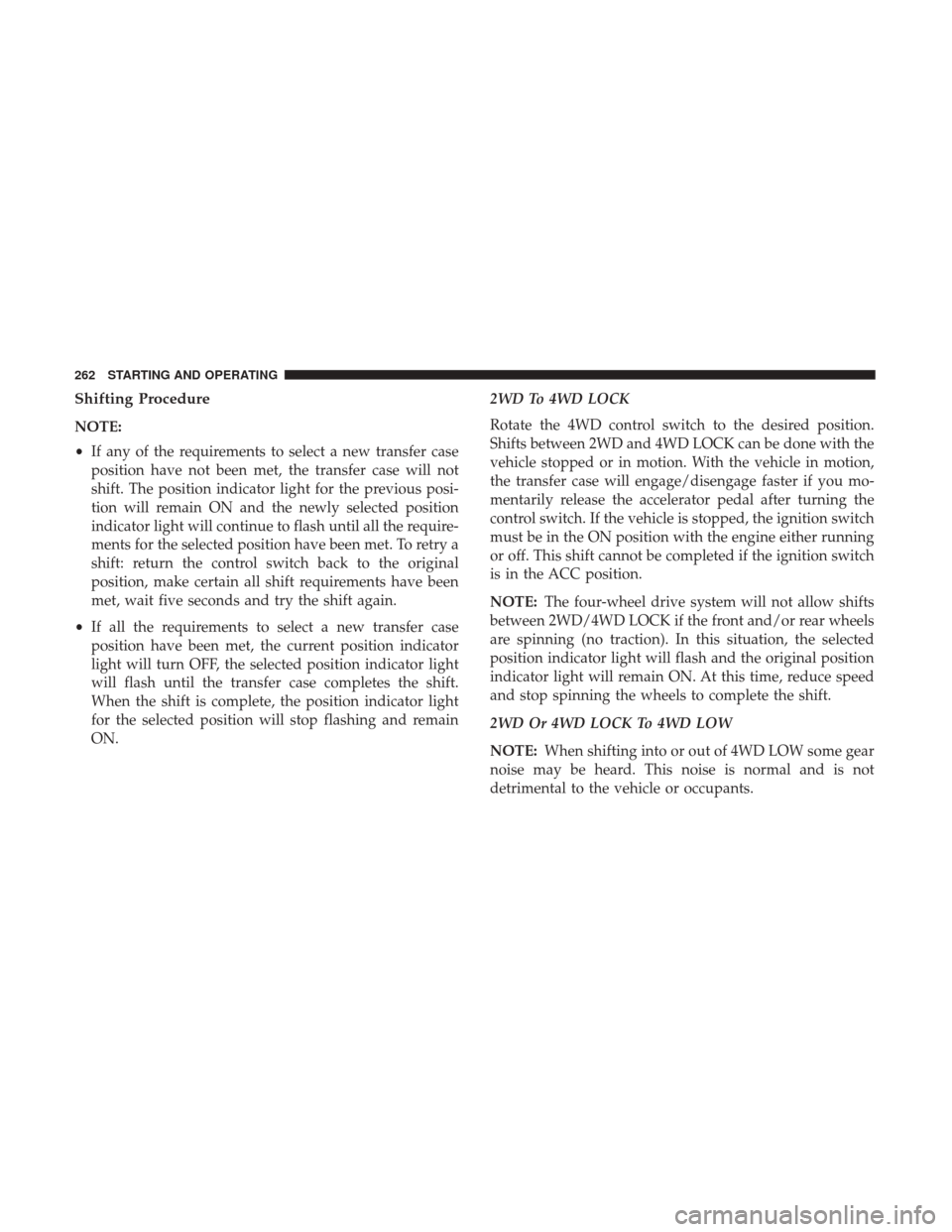
Shifting Procedure
NOTE:
•If any of the requirements to select a new transfer case
position have not been met, the transfer case will not
shift. The position indicator light for the previous posi-
tion will remain ON and the newly selected position
indicator light will continue to flash until all the require-
ments for the selected position have been met. To retry a
shift: return the control switch back to the original
position, make certain all shift requirements have been
met, wait five seconds and try the shift again.
• If all the requirements to select a new transfer case
position have been met, the current position indicator
light will turn OFF, the selected position indicator light
will flash until the transfer case completes the shift.
When the shift is complete, the position indicator light
for the selected position will stop flashing and remain
ON. 2WD To 4WD LOCK
Rotate the 4WD control switch to the desired position.
Shifts between 2WD and 4WD LOCK can be done with the
vehicle stopped or in motion. With the vehicle in motion,
the transfer case will engage/disengage faster if you mo-
mentarily release the accelerator pedal after turning the
control switch. If the vehicle is stopped, the ignition switch
must be in the ON position with the engine either running
or off. This shift cannot be completed if the ignition switch
is in the ACC position.
NOTE:
The four-wheel drive system will not allow shifts
between 2WD/4WD LOCK if the front and/or rear wheels
are spinning (no traction). In this situation, the selected
position indicator light will flash and the original position
indicator light will remain ON. At this time, reduce speed
and stop spinning the wheels to complete the shift.
2WD Or 4WD LOCK To 4WD LOW
NOTE: When shifting into or out of 4WD LOW some gear
noise may be heard. This noise is normal and is not
detrimental to the vehicle or occupants.
262 STARTING AND OPERATING
Page 265 of 527
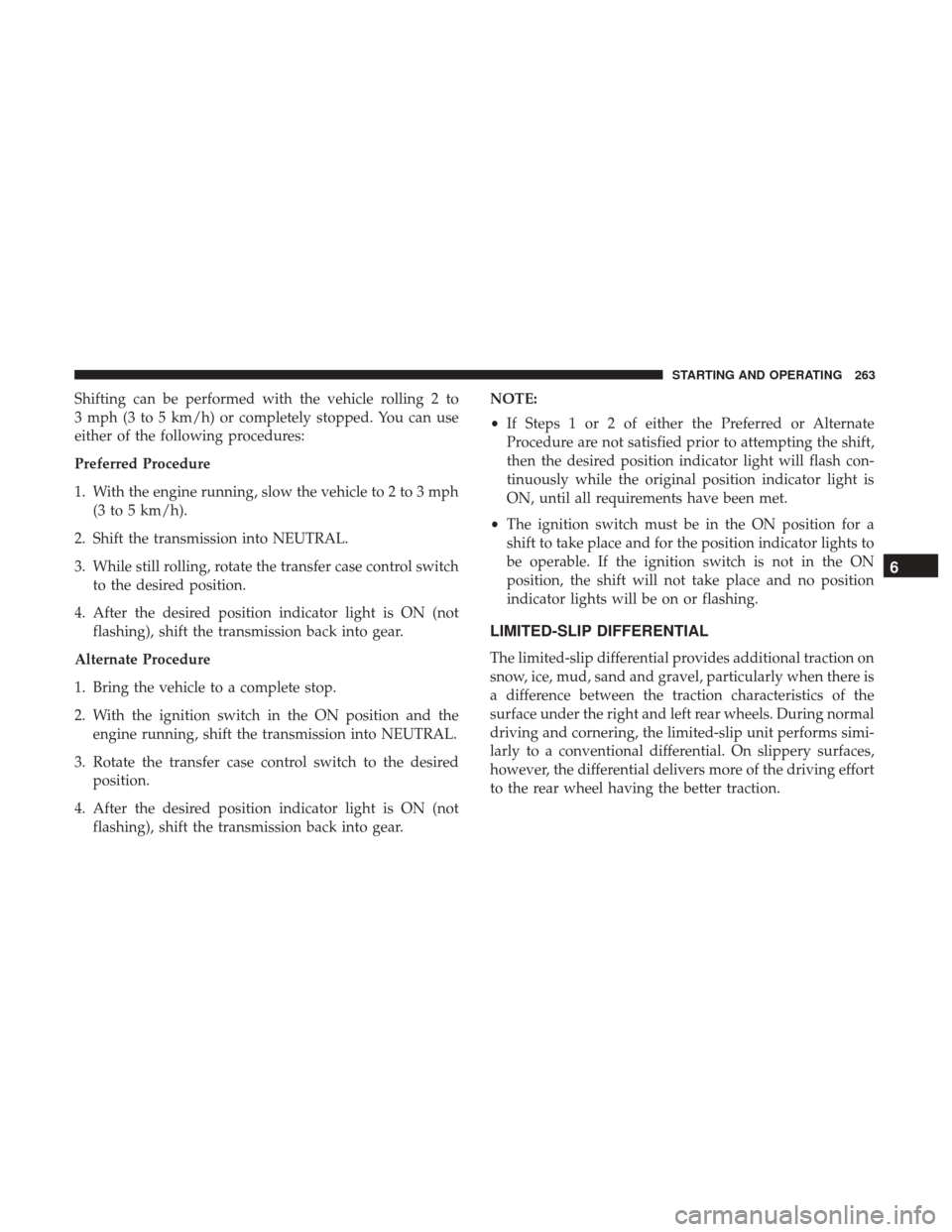
Shifting can be performed with the vehicle rolling 2 to
3 mph (3 to 5 km/h) or completely stopped. You can use
either of the following procedures:
Preferred Procedure
1. With the engine running, slow the vehicle to 2 to 3 mph(3 to 5 km/h).
2. Shift the transmission into NEUTRAL.
3. While still rolling, rotate the transfer case control switch to the desired position.
4. After the desired position indicator light is ON (not flashing), shift the transmission back into gear.
Alternate Procedure
1. Bring the vehicle to a complete stop.
2. With the ignition switch in the ON position and the engine running, shift the transmission into NEUTRAL.
3. Rotate the transfer case control switch to the desired position.
4. After the desired position indicator light is ON (not flashing), shift the transmission back into gear. NOTE:
•
If Steps 1 or 2 of either the Preferred or Alternate
Procedure are not satisfied prior to attempting the shift,
then the desired position indicator light will flash con-
tinuously while the original position indicator light is
ON, until all requirements have been met.
• The ignition switch must be in the ON position for a
shift to take place and for the position indicator lights to
be operable. If the ignition switch is not in the ON
position, the shift will not take place and no position
indicator lights will be on or flashing.
LIMITED-SLIP DIFFERENTIAL
The limited-slip differential provides additional traction on
snow, ice, mud, sand and gravel, particularly when there is
a difference between the traction characteristics of the
surface under the right and left rear wheels. During normal
driving and cornering, the limited-slip unit performs simi-
larly to a conventional differential. On slippery surfaces,
however, the differential delivers more of the driving effort
to the rear wheel having the better traction.
6
STARTING AND OPERATING 263
Page 266 of 527

The limited-slip differential is especially helpful during
slippery driving conditions. With both rear wheels on a
slippery surface, a slight application of the accelerator will
supply maximum traction. When starting with only one
rear wheel on an excessively slippery surface, slight mo-
mentary application of the parking brake may be necessary
to gain maximum traction.
WARNING!
On vehicles equipped with a limited-slip differential
never run the engine with one rear wheel off the
ground since the vehicle may drive through the rear
wheel remaining on the ground. You could lose control
of the vehicle.
Care should be taken to avoid sudden accelerations when
both rear wheels are on a slippery surface. This could cause
both rear wheels to spin, and allow the vehicle to slide
sideways on the crowned surface of a road or in a turn.
POWER TAKE OFF OPERATION — IF EQUIPPED
(CHASSIS CAB ONLY)
This vehicle when equipped with PTO Prep and the
AS66RC automatic six-speed, will allow for an aftermarket
upfit with a transmission driven PTO (power take off). The customer will have the ability to operate the PTO in either
a “stationary” or “mobile” mode. The vehicles will be
factory set to the “stationary” mode. To select “mobile”
mode, you will need to enter the commercial vehicle menu
on the instrument cluster screen and select mobile PTO
mode. Details of the PTO selection modes and further PTO
information is available at the Ram Truck Bodybuilders
web site:
www.rambodybuilder.com.
AS66RC Six-Speed Automatic Transmission Only
The PTO drive gear (part of the AS66RC) operates at torque
converter turbine speed. The turbine speed will be less
than engine speed when the torque converter clutch is not
engaged and will be same as engine speed when the torque
converter clutch is engaged.
Stationary Mode
To operate the PTO in this mode the vehicle must meet the
following conditions:
• Transmission in PARK position (vehicles equipped with
automatic transmission.)
• PTO switch has been activated.
• Parking brake applied (vehicles equipped with manual
transmission).
264 STARTING AND OPERATING
Page 316 of 527

9. Start the engine.
10. Press and hold the brake pedal.
11. Release the parking brake.
12. Shift the transmission into gear, release the brake pedal(and clutch pedal on manual transmissions), and check
that the vehicle operates normally.
NOTE: With electronic shift transfer case:
• Steps 3 and 4 are requirements that must be met before
pushing the button to shift out of NEUTRAL (N), and
must continue to be met until the shift has been com-
pleted. If any of these requirements are not met before
pushing the button or are no longer met during the shift,
the NEUTRAL (N) indicator light will flash continu-
ously until all requirements are met or until the button is
released.
• The ignition must be in the ON/RUN mode for a shift to
take place and for the position indicator lights to be
operable. If the ignition is not in the ON/RUN mode, the
shift will not take place and no position indicator lights
will be on or flashing.
• A flashing NEUTRAL (N) position indicator light indi-
cates that shift requirements have not been met.DRIVING TIPS
Driving On Slippery Surfaces
Acceleration
Rapid acceleration on snow covered, wet, or other slippery
surfaces may cause the driving wheels to pull erratically to
the right or left. This phenomenon occurs when there is a
difference in the surface traction under the rear (driving)
wheels.
WARNING!
Rapid acceleration on slippery surfaces is dangerous.
Unequal traction can cause sudden pulling of the rear
wheels. You could lose control of the vehicle and
possibly have a collision. Accelerate slowly and care-
fully whenever there is likely to be poor traction (ice,
snow, wet, mud, loose sand, etc.).
Driving Through Water
Driving through water more than a few inches/centimeters
deep will require extra caution to ensure safety and pre-
vent damage to your vehicle.
314 STARTING AND OPERATING
Page 409 of 527

It is recommended you contact your authorized tire dealer
or original equipment dealer with any questions you may
have on tire specifications or capability. Failure to use
equivalent replacement tires may adversely affect the
safety, handling, and ride of your vehicle.
WARNING!
•Do not use a tire, wheel size, load rating, or speed
rating other than that specified for your vehicle.
Some combinations of unapproved tires and wheels
may change suspension dimensions and perfor-
mance characteristics, resulting in changes to steer-
ing, handling, and braking of your vehicle. This can
cause unpredictable handling and stress to steering
and suspension components. You could lose control
and have a collision resulting in serious injury or
death. Use only the tire and wheel sizes with load
ratings approved for your vehicle.
• Never use a tire with a smaller load index or capacity,
other than what was originally equipped on your
vehicle. Using a tire with a smaller load index could
result in tire overloading and failure. You could lose
control and have a collision.
(Continued)
WARNING! (Continued)
•Failure to equip your vehicle with tires having ad-
equate speed capability can result in sudden tire
failure and loss of vehicle control.
CAUTION!
Replacing original tires with tires of a different size
may result in false speedometer and odometer read-
ings.
Tire Types
All Season Tires — If Equipped
All Season tires provide traction for all seasons (Spring,
Summer, Fall, and Winter). Traction levels may vary be-
tween different all season tires. All season tires can be
identified by the M+S, M&S, M/S or MS designation on the
tire sidewall. Use all season tires only in sets of four; failure
to do so may adversely affect the safety and handling of
your vehicle.
8
SERVICING AND MAINTENANCE 407
Page 410 of 527
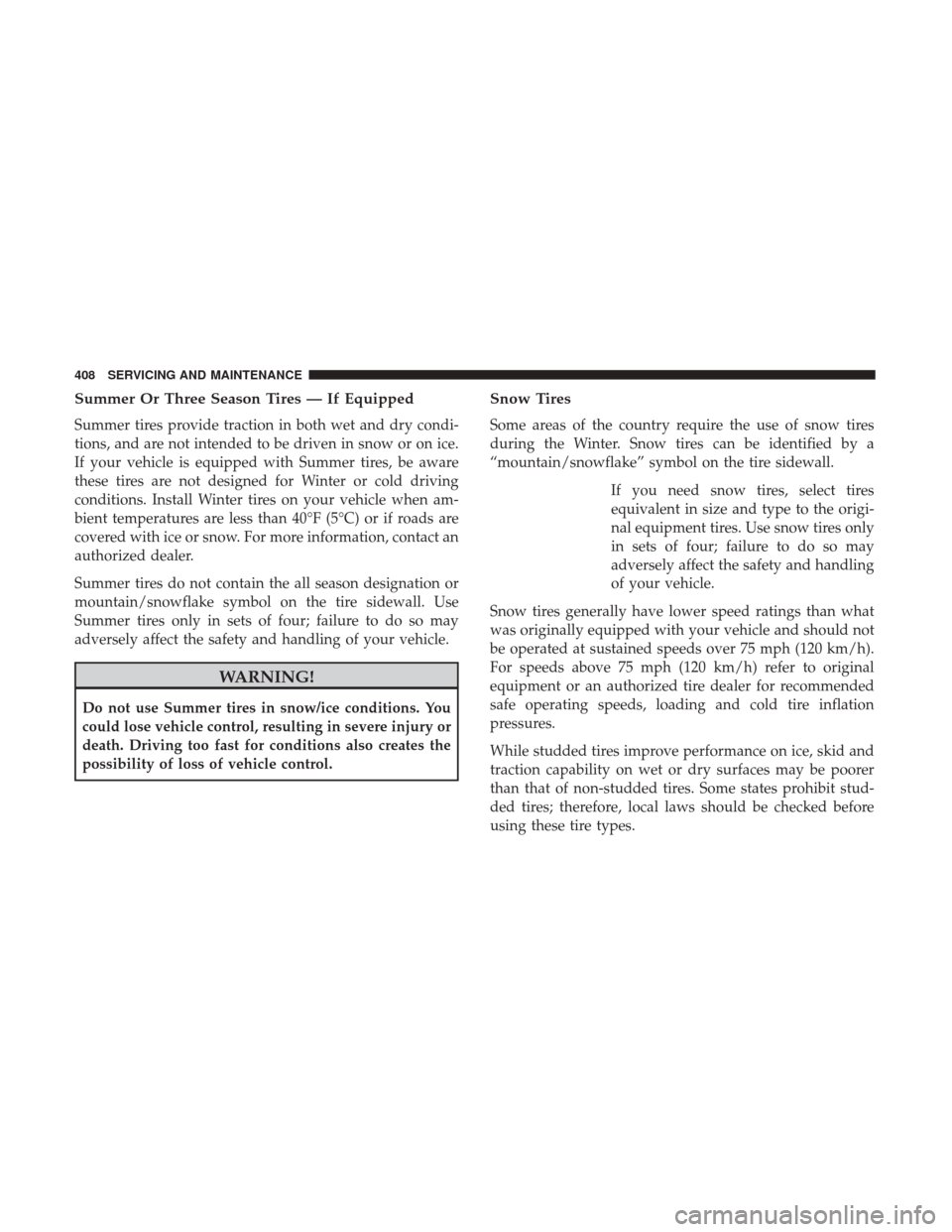
Summer Or Three Season Tires — If Equipped
Summer tires provide traction in both wet and dry condi-
tions, and are not intended to be driven in snow or on ice.
If your vehicle is equipped with Summer tires, be aware
these tires are not designed for Winter or cold driving
conditions. Install Winter tires on your vehicle when am-
bient temperatures are less than 40°F (5°C) or if roads are
covered with ice or snow. For more information, contact an
authorized dealer.
Summer tires do not contain the all season designation or
mountain/snowflake symbol on the tire sidewall. Use
Summer tires only in sets of four; failure to do so may
adversely affect the safety and handling of your vehicle.
WARNING!
Do not use Summer tires in snow/ice conditions. You
could lose vehicle control, resulting in severe injury or
death. Driving too fast for conditions also creates the
possibility of loss of vehicle control.
Snow Tires
Some areas of the country require the use of snow tires
during the Winter. Snow tires can be identified by a
“mountain/snowflake” symbol on the tire sidewall.If you need snow tires, select tires
equivalent in size and type to the origi-
nal equipment tires. Use snow tires only
in sets of four; failure to do so may
adversely affect the safety and handling
of your vehicle.
Snow tires generally have lower speed ratings than what
was originally equipped with your vehicle and should not
be operated at sustained speeds over 75 mph (120 km/h).
For speeds above 75 mph (120 km/h) refer to original
equipment or an authorized tire dealer for recommended
safe operating speeds, loading and cold tire inflation
pressures.
While studded tires improve performance on ice, skid and
traction capability on wet or dry surfaces may be poorer
than that of non-studded tires. Some states prohibit stud-
ded tires; therefore, local laws should be checked before
using these tire types.
408 SERVICING AND MAINTENANCE
Page 415 of 527
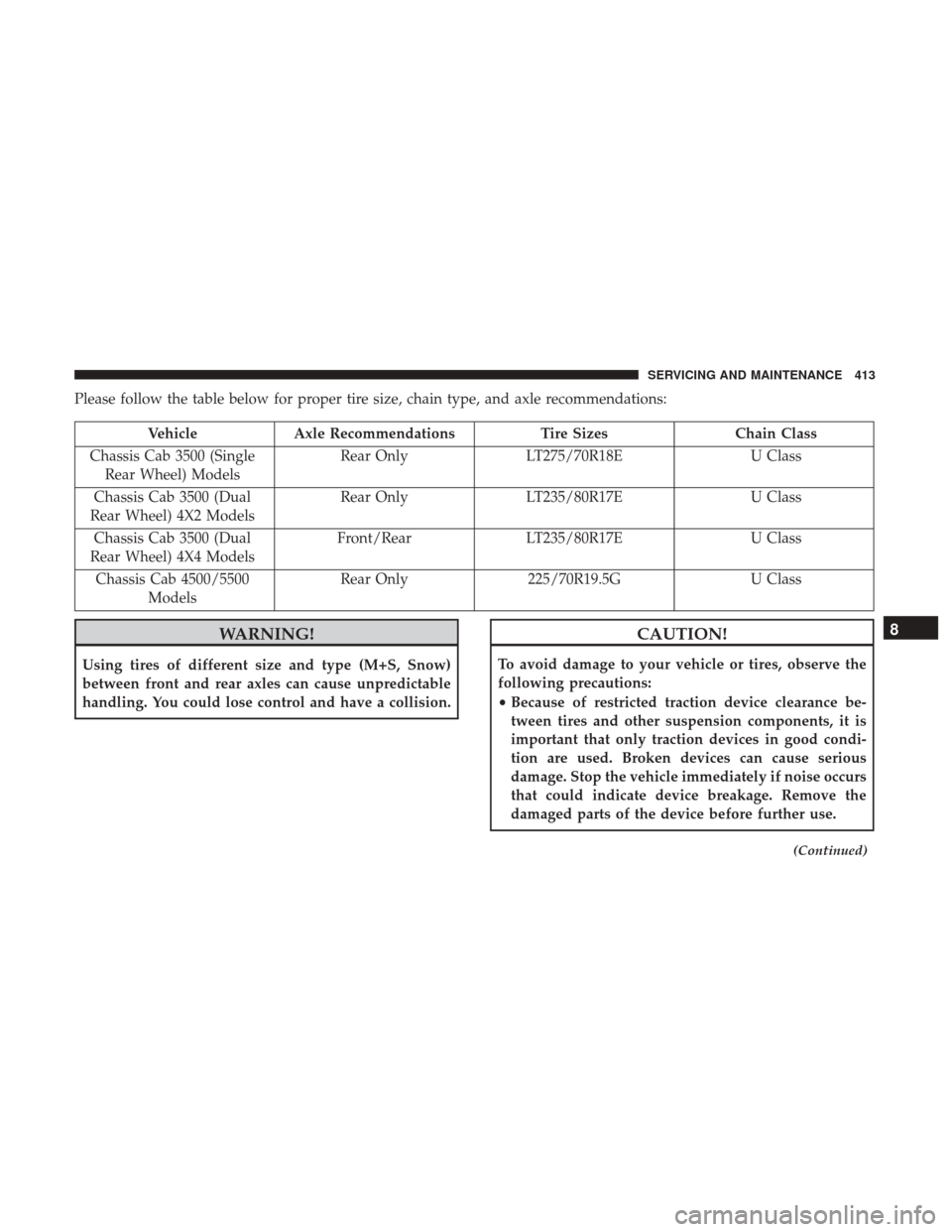
Please follow the table below for proper tire size, chain type, and axle recommendations:
VehicleAxle Recommendations Tire SizesChain Class
Chassis Cab 3500 (Single Rear Wheel) Models Rear Only
LT275/70R18E U Class
Chassis Cab 3500 (Dual
Rear Wheel) 4X2 Models Rear Only
LT235/80R17E U Class
Chassis Cab 3500 (Dual
Rear Wheel) 4X4 Models Front/Rear
LT235/80R17E U Class
Chassis Cab 4500/5500 Models Rear Only
225/70R19.5G U Class
WARNING!
Using tires of different size and type (M+S, Snow)
between front and rear axles can cause unpredictable
handling. You could lose control and have a collision.
CAUTION!
To avoid damage to your vehicle or tires, observe the
following precautions:
•Because of restricted traction device clearance be-
tween tires and other suspension components, it is
important that only traction devices in good condi-
tion are used. Broken devices can cause serious
damage. Stop the vehicle immediately if noise occurs
that could indicate device breakage. Remove the
damaged parts of the device before further use.
(Continued)
8
SERVICING AND MAINTENANCE 413
Page 418 of 527
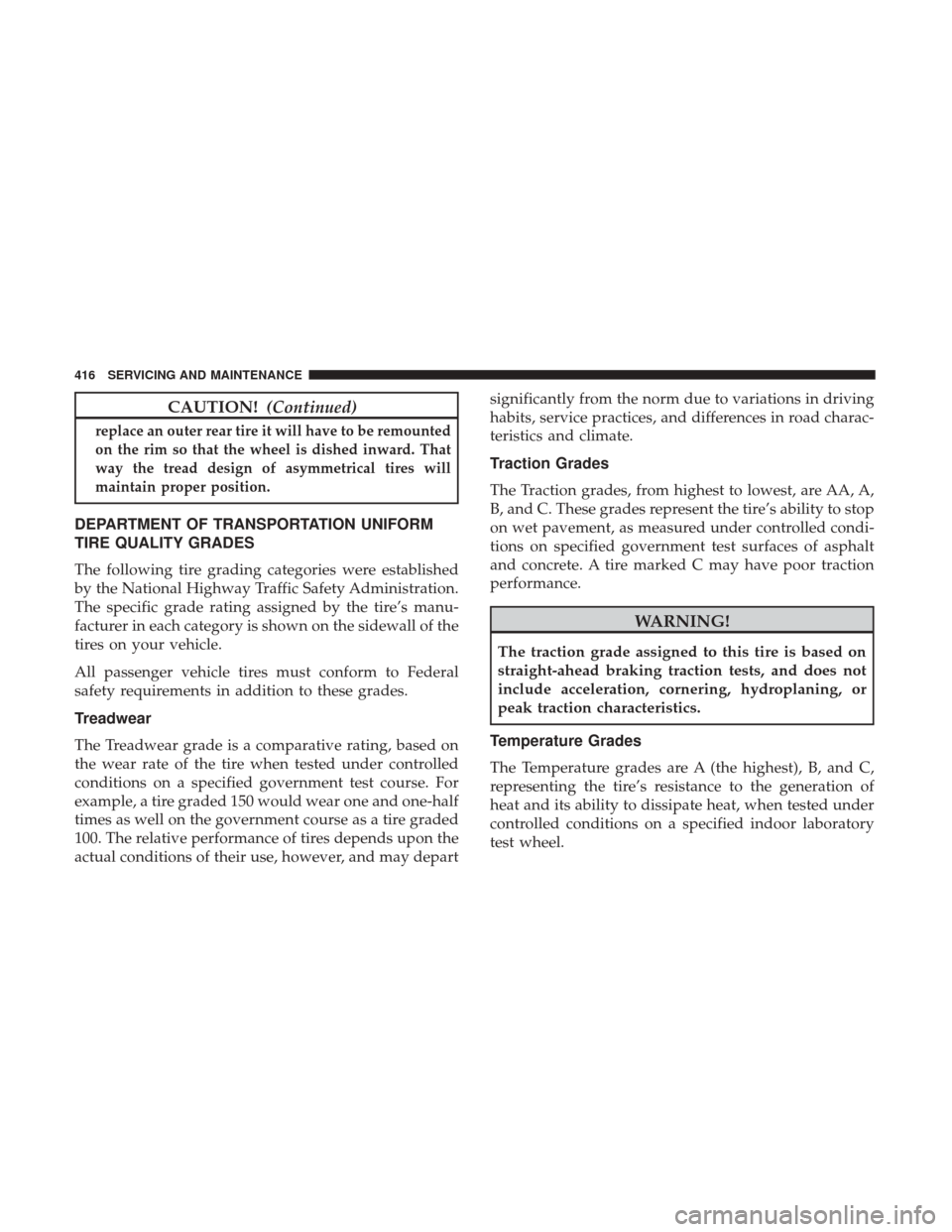
CAUTION!(Continued)
replace an outer rear tire it will have to be remounted
on the rim so that the wheel is dished inward. That
way the tread design of asymmetrical tires will
maintain proper position.
DEPARTMENT OF TRANSPORTATION UNIFORM
TIRE QUALITY GRADES
The following tire grading categories were established
by the National Highway Traffic Safety Administration.
The specific grade rating assigned by the tire’s manu-
facturer in each category is shown on the sidewall of the
tires on your vehicle.
All passenger vehicle tires must conform to Federal
safety requirements in addition to these grades.
Treadwear
The Treadwear grade is a comparative rating, based on
the wear rate of the tire when tested under controlled
conditions on a specified government test course. For
example, a tire graded 150 would wear one and one-half
times as well on the government course as a tire graded
100. The relative performance of tires depends upon the
actual conditions of their use, however, and may depart significantly from the norm due to variations in driving
habits, service practices, and differences in road charac-
teristics and climate.
Traction Grades
The Traction grades, from highest to lowest, are AA, A,
B, and C. These grades represent the tire’s ability to stop
on wet pavement, as measured under controlled condi-
tions on specified government test surfaces of asphalt
and concrete. A tire marked C may have poor traction
performance.
WARNING!
The traction grade assigned to this tire is based on
straight-ahead braking traction tests, and does not
include acceleration, cornering, hydroplaning, or
peak traction characteristics.
Temperature Grades
The Temperature grades are A (the highest), B, and C,
representing the tire’s resistance to the generation of
heat and its ability to dissipate heat, when tested under
controlled conditions on a specified indoor laboratory
test wheel.
416 SERVICING AND MAINTENANCE
Page 515 of 527
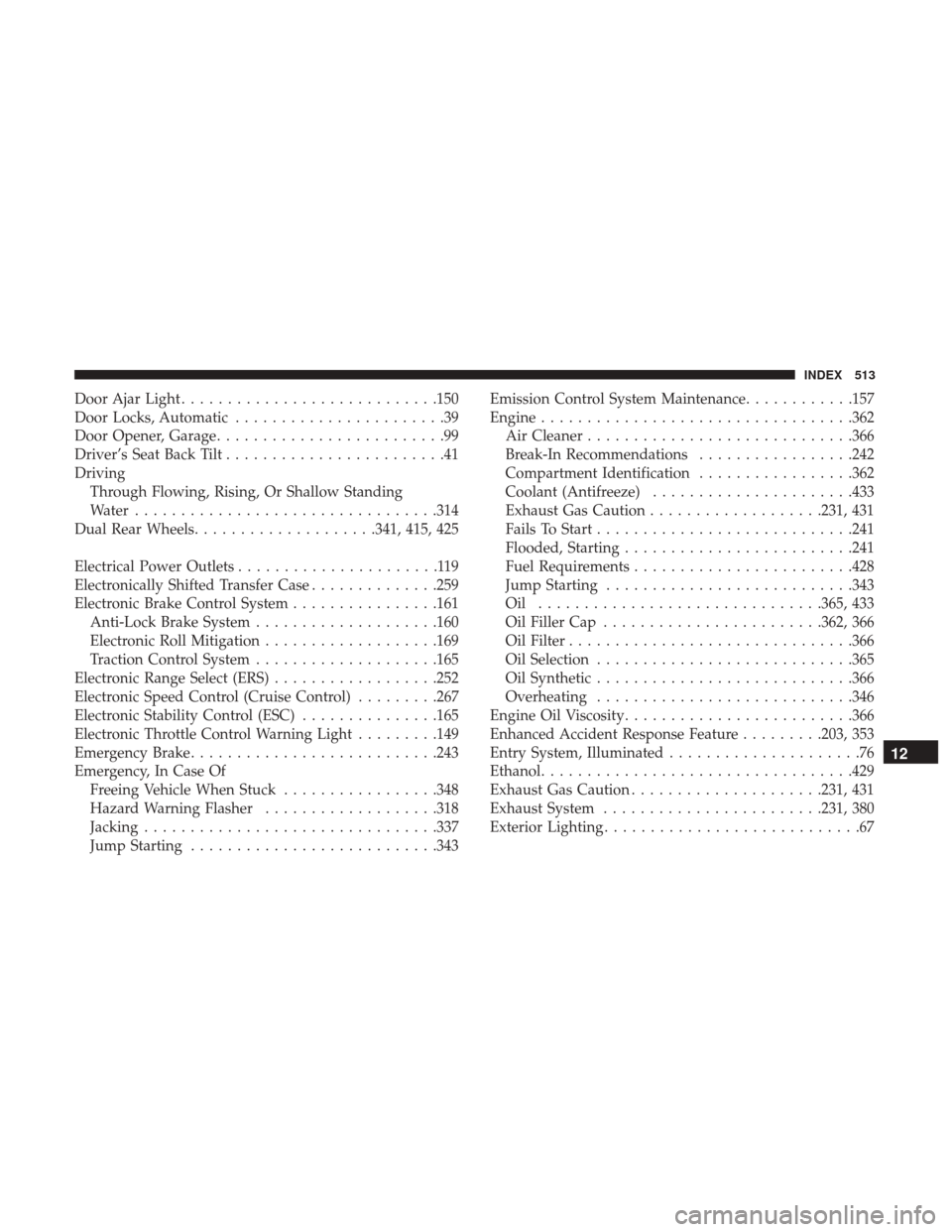
Door Ajar Light........................... .150
Door Locks, Automatic .......................39
Door Opener, Garage .........................99
Driver’s Seat Back Tilt ........................41
Driving Through Flowing, Rising, Or Shallow Standing
Water ................................ .314
Dual Rear Wheels ....................341, 415, 425
Electrical Power Outlets ......................119
Electronically Shifted Transfer Case ..............259
Electronic Brake Control System ................161
Anti-Lock Brake System ....................160
Electronic Roll Mitigation ...................169
Traction Control System ....................165
Electronic Range Select (ERS)..................252
Electronic Speed Control (Cruise Control) .........267
Electronic Stability Control (ESC) ...............165
Electronic Throttle Control Warning Light .........149
Emergency Brake .......................... .243
Emergency, In Case Of Freeing Vehicle When Stuck .................348
Hazard Warning Flasher ...................318
Jacking ............................... .337
Jump Starting .......................... .343Emission Control System Maintenance
............157
Engine ................................. .362
Air Cleaner ............................ .366
Break-In Recommendations .................242
Compartment Identification .................362
Coolant (Antifreeze) ..................... .433
Exhaust Gas Caution ...................231, 431
Fails To Start ........................... .241
Flooded, Starting ........................ .241
Fuel Requirements ....................... .428
Jump Starting .......................... .343
Oil .............................. .365, 433
Oil Filler Cap ....................... .362, 366
Oil Filter .............................. .366
Oil
Selection ........................... .365
Oil Synthetic ........................... .366
Overheating ........................... .346
Engine Oil Viscosity ........................ .366
Enhanced Accident Response Feature .........203, 353
Entry System, Illuminated .....................76
Ethanol ................................. .429
Exhaust Gas Caution .....................231, 431
Exhaust System ....................... .231, 380
Exterior Lighting ............................67
12
INDEX 513
Page 519 of 527

Passing................................70
Seat Belt Reminder ...................... .147
Security Alarm ......................... .148
Service ............................... .323
Tire Pressure Monitoring (TPMS) ..........152, 172
Traction Control ........................ .168
Transfer Case .......................... .258
Turn Signal ....................73, 155, 234, 324
Warning (Instrument Cluster Description) . . . .148, 155
Limited-Slip Differential ..................263, 391
Loading Vehicle ........................... .288
Tires................................. .398
Load Shed Battery Saver Mode ...................... .145
Battery Saver On ........................ .145
Electrical Load Reduction ...................145
Intelligent Battery Sensor ...................145
Locks Automatic Door ..........................39
Child Protection ..........................40
Power Door .............................36
Low Tire Pressure System .....................172
Lubrication, Body ......................... .376
Lug Nuts ............................ .341, 425Maintenance Free Battery
.....................363
Maintenance Schedule ...................... .357
Malfunction Indicator Light (Check Engine) . . . .150, 157
Manual, Service ........................... .508
Manual Transmission Fluid Level Check ....................... .391
Memory Feature (Memory Seat) .................41
Memory Seat ........................... .41, 47
Memory Seats And Radio .....................41
Methanol ............................... .429
Mirrors ..................................59
Electric Powered ..........................62
Heated .................................65
Memory ................................47
Outside ................................61
Rearview ........................ .59, 60, 318
Trailer Towing ...........................65
Modifications/Alterations,
Vehicle................7
Monitor, Tire Pressure System ..................172
Mopar Parts ............................. .507
Multi-Function Control Lever ...................69
Navigation System (Uconnect GPS) ..............284
New Vehicle Break-In Period ..................242
12
INDEX 517